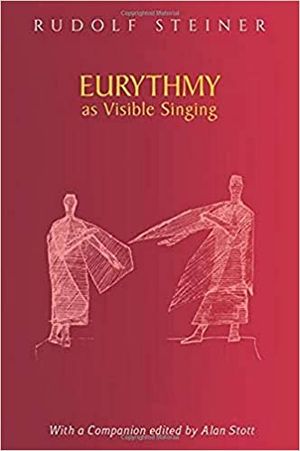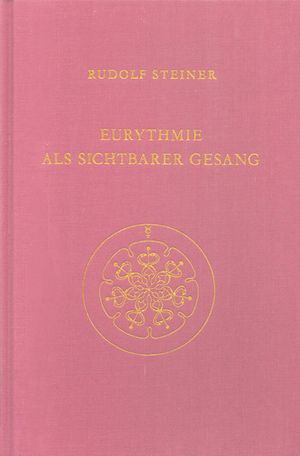GA 278: Difference between revisions
(Created page with "thumb == Eurythmy as Visible Singing == === Eurythmie als sichtbarer Gesang (Ton-Eurythmie-Kurs) === An essay from 2 March 1924 and eight lectures given in...") |
No edit summary |
||
| (One intermediate revision by the same user not shown) | |||
| Line 1: | Line 1: | ||
[[File:GA278 en 2019.jpg|thumb]] | |||
[[File:GA278.jpg|thumb]] | [[File:GA278.jpg|thumb]] | ||
== Eurythmy as Visible Singing == | == Eurythmy as Visible Singing == | ||
| Line 13: | Line 14: | ||
== Literature == | == Literature == | ||
* [[Rudolf Steiner]], A. Stott (Translator): ''Eurythmy as Visible Singing''. '''CW 278'''. 8 lectures, Dornach, Feb. 19-27 1924. Rudolf Steiner Press 2019. ISBN 978-1855845671 | * [[Rudolf Steiner]], A. Stott (Translator): ''Eurythmy as Visible Singing''. '''CW 278'''. 8 lectures, Dornach, Feb. 19-27 1924. Rudolf Steiner Press 2019. ISBN 978-1855845671 {{rsarchive|278}} | ||
=== German === | === German === | ||
* [[Rudolf Steiner]]: ''Eurythmie als sichtbarer Gesang'', [[GA 278]] (2001), ISBN 3-7274-2781-7 {{Lectures|278}} | * [[Rudolf Steiner]]: ''Eurythmie als sichtbarer Gesang'', [[GA 278]] (2001), ISBN 3-7274-2781-7 {{Lectures|278}} | ||
Latest revision as of 14:58, 7 September 2021


Eurythmy as Visible Singing
Eurythmie als sichtbarer Gesang (Ton-Eurythmie-Kurs)
An essay from 2 March 1924 and eight lectures given in Dornach from 19 to 27 February 1924, with accompanying notebook entries.
„The study of music is the study of the human being. The two are inseparable, and eurythmy is the art that brings this most clearly to expression. In these lectures, Rudolf Steiner guides us along a path toward an understanding of the human form as music comes to rest--the movements of eurythmy bringing this music back to life.“
„Fundamentally speaking, music is the human being, and indeed it is from music that we rightly learn how to free ourselves from matter.“
Contents
The major and minor experience / The gesture of the musical / The dissolution of the chord and the harmonic into the melos / The moving forward of musical motifs in time / Choral eurythmy / The insistent note and the pause / The approach to musical eurythmy lies in the collarbone / Pitch, duration of tone, strength of tone, change of tempo / Enclosure: Notes on the lectures (facsimile reproductions)
Literature
- Rudolf Steiner, A. Stott (Translator): Eurythmy as Visible Singing. CW 278. 8 lectures, Dornach, Feb. 19-27 1924. Rudolf Steiner Press 2019. ISBN 978-1855845671 rsarchive.org
German
- Rudolf Steiner: Eurythmie als sichtbarer Gesang, GA 278 (2001), ISBN 3-7274-2781-7 English: rsarchive.org German: pdf pdf(2) html mobi epub archive.org
 |
References to the work of Rudolf Steiner follow Rudolf Steiner's Collected Works (CW or GA), Rudolf Steiner Verlag, Dornach/Switzerland, unless otherwise stated.
Email: verlag@steinerverlag.com URL: www.steinerverlag.com. Index to the Complete Works of Rudolf Steiner - Aelzina Books A complete list by Volume Number and a full list of known English translations you may also find at Rudolf Steiner's Collected Works Rudolf Steiner Archive - The largest online collection of Rudolf Steiner's books, lectures and articles in English. Rudolf Steiner Audio - Recorded and Read by Dale Brunsvold steinerbooks.org - Anthroposophic Press Inc. (USA) Rudolf Steiner Handbook - Christian Karl's proven standard work for orientation in Rudolf Steiner's Collected Works for free download as PDF. |
